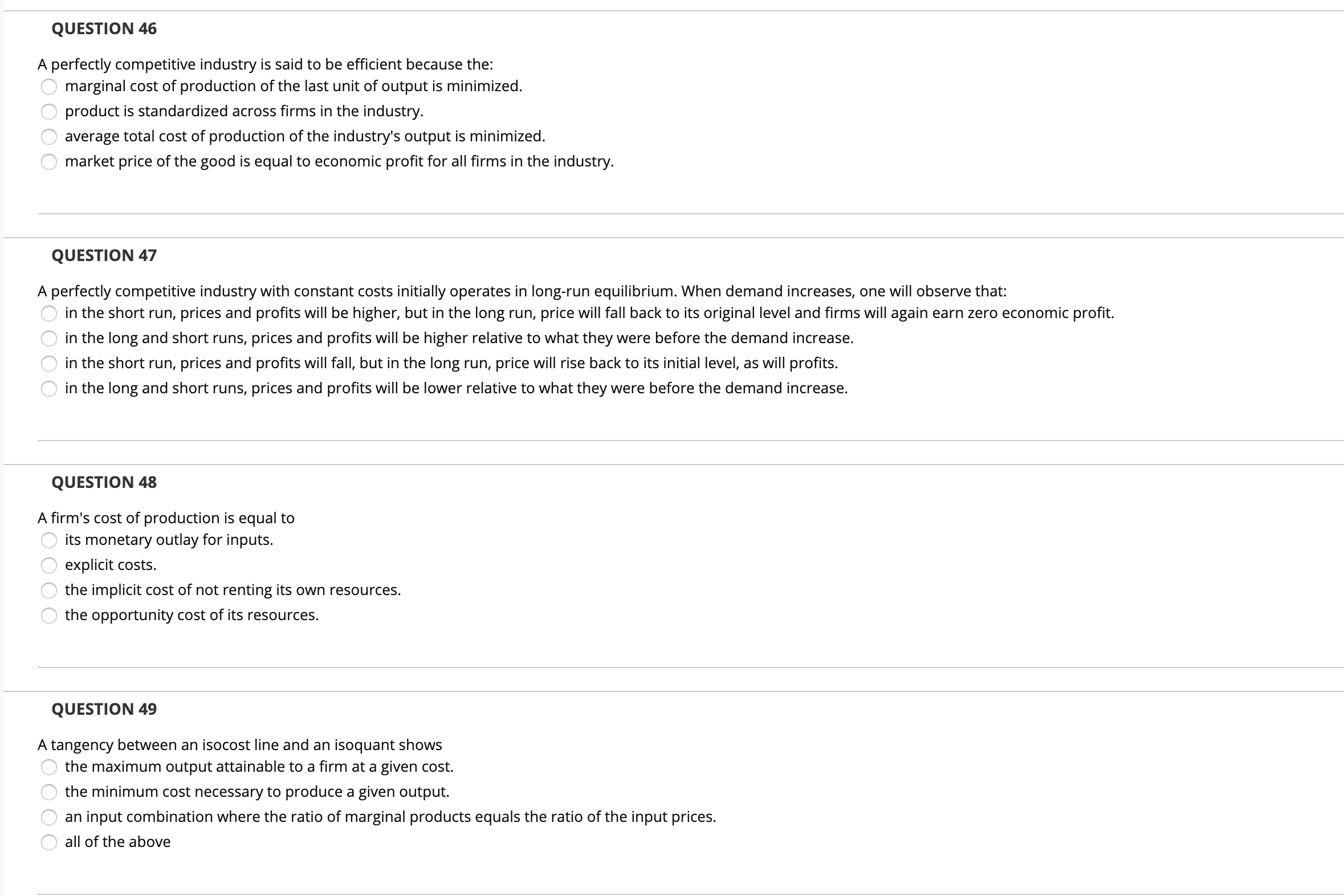Multiple Choice
QUESTION 42 A perfectly competitive firm is a: price-taker. price-searcher. cost-maximizer. quantity-taker. QUESTION 43 A perfectly competitive firm is definitely earning an economic profit when: MR > MC. O P > ATC. O P > MC. O P > AVC. QUESTION 44 A perfectly competitive firm's marginal cost curve above the average variable cost curve is its: input demand curve. short-run supply curve. marginal revenue curve. total revenue curve. QUESTION 45 A perfectly competitive industry is in a state of long-run equilibrium. Which of the following must be true? O P = MR = MC > ATC. O P = MR = MC = AVC. O P = MR = MC = ATC. O P > MR = MC = AVC.QUESTION 46 A perfectly competitive industry is said to be efficient because the: O marginal cost of production of the last unit of output is minimized. 0 product is standardized across rms in the industry. 0 average total cost of production of the industry's output is minimized. \"7 market price of the good is equal to economic prot for all rms in the industry. QUESTION 47 A perfectly competitive industry with constant costs initially operates in longrun equilibrium. When demand increases, one will observe that: O in the short run, prices and prots will be higher, but in the long run, price will fall back to its original level and rms will again earn zero economic prot. (j. in the long and short runs, prices and prots will be higher relative to what they were before the demand increase. 0 in the short run, prices and prots will fall, but in the long run, price will rise back to its initial level, as will prots. 0 in the long and short runs, prices and prots will be lower relative to what they were before the demand increase. QUESTION 48 A rm's cost of production is equal to 0 its monetary outlay for inputs. 0 explicit costs. 0 the implicit cost of not renting its own resources. 0 the opportunity cost of its resources. QUESTION 49 A tangency between an isocost line and an isoquant shows 0 the maximum output attainable to a rm at a given cost. 0 the minimum cost necessary to produce a given output. 0 an input combination where the ratio of marginal products equals the ratio of the input prices. 0 all ofthe above QUESTION 50 As long as there is free entry into a market: A A. firms in that market can sustain prices above average total cost. A B. economic prots are not sustainable. A C. accounting prots will be zero. A D.firms in that market can maintain market power. QUESTION 51 Free entry and exit does not exist when A there is no differential impediments across rms in the mobility of resources into and out of an industry. A a firm experiences economies of scale. A an incumbent rm has an exclusive government patent. A a firm experiences diseconomies of scale. QUESTION 52 If price remains above the average total cost for firms in a competitive industry: A A. new rms will enter that industry. A B. the number of rms in the industry will neither increase nor decrease. A C. existing firms will exit that industry. A D.the existing rms will be making zero economic prot. QUESTION 53 If the marginal product of labor is four times the marginal product of capital and the price of labor is twice the price of capital, then A labor will be substituted for capital. A capital will be substituted for labor. A output should be contracted using the same input levels. A the answer cannot be determined without knowing relative prices QUESTION 54 In the short run, if price falls, the firm will respond by A shutting down. A equating average variable cost to marginal revenue. A reducing output along its marginal cost curve as long as marginal revenue exceeds average variable cost. A none of the above QUESTION 55 Markets may fail to achieve Pareto optimality (i,e., economic efficiency) due to A market power imperfect information l externalities/public goods l all of the above '7) C) C: 'I A) QUESTION 56 Opportunity cost is A sunk cost plus implicit cost. A explicit cost plus economic cost. A implicit cost plus explicit cost. A explicit cost plus sunk cost. QUESTION 57 The expansion path identies A the least costly combination of inputs required to produce various levels ofoutput. A the rm's demand curves for the inputs. A the various combinations of inputs that can be used to produce a given level of output. A the least-cost combination of outputs. QUESTION 58 The perfectly competitive firm minimizes losses by shutting down whenever price is below average fixed costs. price is below the minimum point of the average cost curve. price is below the minimum point of the average variable cost curve. total variable costs are greater than total fixed costs. QUESTION 59 The short-run supply curve for a competitive industry is found by summing the supply curves of all the firms horizontally. the industry marginal cost curve. found by summing the firms' supply curves vertically. O horizontal because there are many buyers and sellers. QUESTION 60 Which of the following will occur in response to an unexpected increase in demand in a constant-cost, competitive industry? A. The output will increase with input prices remaining unchanged B. The output of the industry will remain constant. C. Resources will move out of the industry. O D. The existing firms will not be able to expand output sufficiently without incurring huge costs. QUESTION 61 Which one of the following is not an assumption of the competitive model? homogeneous product unrestricted mobility of resources economies of scale possession of all relevant information











